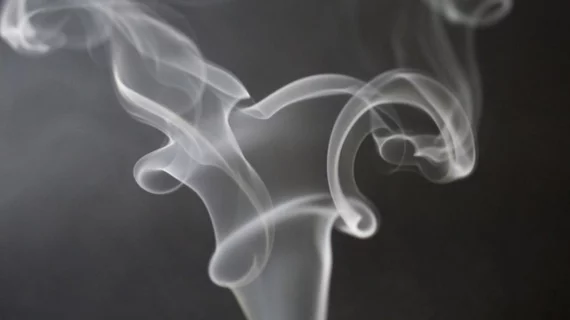Chronic exposure to secondhand smoke in common settings like cars, homes and casinos may increase a person’s susceptibility to cardiac alternans, a precursor to ventricular arrhythmias, according to an animal study published in Environmental Health Perspectives.
The incidence of tobacco use in the U.S. is declining, first author Crystal Ripplinger, PhD, and colleagues wrote in the journal—likely due to the implementation of numerous smoke-free laws and targeted mass-media campaigns that have saturated the past decade. But while cigarette use might be down, Ripplinger et al. said 58 million Americans were still exposed to secondhand smoke in 2011, and research in the area is declining.
“Several studies have reported decreased heart rate variability (HRV) after secondhand smoke exposure in both humans and animal models,” the authors wrote. “Our group previously showed that secondhand smoke exposure decreased HRV and increased the susceptibility to arrhythmias in mice, particularly the susceptibility to pacing-induced ventricular tachycardia/fibrillation (VT/VF), a life-threatening arrhythmia associated with sudden cardiac death.”
Since the majority of secondhand smoke-related trials revolve around its relationship with coronary artery disease—a well-established negative connection—Ripplinger and her coauthors exposed a cohort of male lab mice to secondhand smoke and studied its effects on a cellular level, as it relates to arrhythmias.
The researchers mimicked typical human public smoking conditions in a chamber designed for the test mice, who were exposed to differing levels of secondhand smoke for six hours, five days a week for 12 weeks. Mice were tested at four, eight and 12 weeks for calcium levels and their susceptibility to arrhythmias using high-speed imaging and electrocardiograms.
Compared to mice who were exposed only to filtered air during the study, the hearts of mice exposed to secondhand smoke couldn’t tolerate faster rates. Furthermore, the calcium response to those irregularities was sluggish, causing beat-to-beat instability.
“The arrhythmogenic effect of secondhand smoke depended on the duration of exposure,” Ripplinger et al. said. “Shorter-duration (four- and eight-week) exposure did not alter electrophysiological parameters nor the susceptibility to cardiac alternans, whereas longer-term (12-week) exposure significantly increased the susceptibility to both ADP and Ca2+ transient alternans, suggesting that adverse electrophysiological remodeling begins to have a measurable impact on the isolated heart sometime between eight and 12 weeks of exposure.”
The authors said future research should determine whether these changes can be reversed with reduced exposure, since their results are concerning for heart patients already burdened with arrhythmias.
“We showed that secondhand smoke exposure at levels relevant to social situations in humans increased the susceptibility to cardiac alternans, a known precursor for severe ventricular arrhythmias, including VT/VF,” they wrote. “These data may provide a critical mechanistic link between secondhand smoke exposure and arrhythmia susceptibility.”

